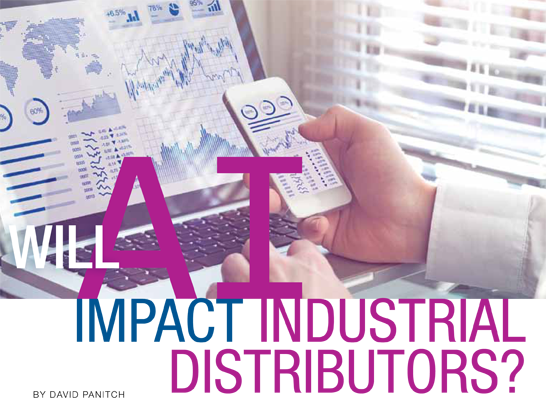Will AI Impact Industrial Distributors?

by David Panitch
The obvious answer is yes, but there are many nuances to that answer. Let’s first start with better defining artificial intelligence (AI).
AI encompasses a number of technology innovations. It is a catchall for technology such as machine learning, Internet of Things (IoT), Industrial Internet of Things (IIoT), embedded analytics, big data, among others. Before you dismiss AI as something that is not going to work in your distribution organization, look around. You may be surprised by some of the technology that you are already using which might be considered AI. Do you have key performance indicator dashboards? Are you receiving forecasts or consumption data from your key customers? Have you deployed vending machines on your customer’s plant floors?
If you answered yes to any of the above questions, then you are already embarking on the journey of Artificial Intelligence. If you answered no to those questions that’s OK. You can still take your company on a transformative path that can reap significant benefits. The next questions are much more strategic. Will you continue to transform your business to take advantage of AI as it is further developed with the industrial distributor in mind? Are you ready to develop a transformational strategy that will explore new innovations and attract the human resources that you haven’t employed to date? Let’s take a look at what
distributors should consider as they envision the future.
Certain AI technology can be deployed more easily without much disruption in the organization. Start with reporting of key performance indicators through what is known as embedded analytics. Here is how Gartner (www.gartner.com) defines embedded analytics: “Embedded analytics is the use of reporting and analytic capabilities in transactional business applications. These capabilities can reside outside the application, reusing the analytic infrastructure built by many enterprises, but must be easily accessible from inside the application, without forcing users to switch between systems.”
Many enterprise resource planning (ERP) systems have partnered with business intelligence (BI) platforms to bring to light actionable information that might otherwise be hidden within your ERP system. These BI systems help the user “visualize” their data in ways that highlight information that is important to the business. Some business cases might include:
- Identifying customers whose buying trend has shifted over time. They had been buying 35 different products from you, but the BI identified a change. They are still buying 35 items, but there are three new products that they have begun to buy and three others that they have stopped buying.
- Identifying types of customers and the similarities (or not) of their purchases from you. If, for instance, you have 12 customers in the agriculture equipment aftermarket sector, a strong BI system can help make suggestions of products that they each should buy based on the purchases of this group in aggregate. Suggestive selling is not a new concept, but when you bring in embedded analytics it helps to tailor your suggestions in highly meaningful ways.
- On your procurement side, BI can help you determine if purchasing certain items from vendor A, vendor B, or having them transferred from one of your other locations would be the best decision at this point in time. The multitude of factors that go into that decision could be done in milliseconds through BI rather than having your purchasing team do their own analysis in their heads or by complex spreadsheets that are prone to human error.
Another aspect of AI is what we believe is the confluence of machine learning and IoT. While you can have one without the other, their power increases exponentially when they are designed to work together.
For a distributor this may have both internal and external impacts. Consider a distributor’s fleet of trucks. The combining of monitors (GPS, engine life indicators, temperature gages, etc.) can bring increased efficiencies in routing, maintenance schedules and overall vehicle and driver productivity. Even tracking the time at each stop can be analyzed and improved upon based on the number of packages being delivered, the type of customer, their receiving dock configuration, etc.
An external example is the information shared by a customer that understands the benefit of a “partner-centric” relationship. Their IoT devices could send signals to the distributor’s ERP system that alerts the distributor of replenishment needs in real time. This would have an economic impact by “right-sizing” the level of on-hand inventory at both the distributor and customer. It will also perform the analysis needed to determine when to ship the product to the customer.
The idea that distributors don’t need to think about AI right now couldn’t be further from the truth. No matter the size of your organization there are scalable efforts that you can undertake that will help move you forward today. Here’s how to get started:
- Begin with a strategy. Take a look at who you are as a distributor, where you fit in the world today and, more importantly, where you want to fit in the future. This is an opportunity to further distinguish your distributorship from others. If you are in a leadership role, be committed. Show support and help to clear the way for your team to excel at this endeavor.
- Next, identify key players in your organization who may possess the interest and, more importantly, the skills to transform your organization. If you don’t have the people who can move your strategy forward, hire them. AI doesn’t work without people. There is clear ROI that can be developed for these initiatives.
- Determine if you have the technology in place to expand your AI strategy and initiatives. You can often get help from your ERP provider, but if that doesn’t work, consulting organizations can guide you toward the best solution for your particular goals and vision. There are tools to fit just about any sized organization.
- Develop the tactical plan to take your company to the next level. Make sure that you have identified all of the key steps in moving your initiatives forward. Determine the timeline and resources necessary to achieve your plan.
- Communicate your direction clearly and often. Make sure that everyone understands where you are headed (the vision). This may include an infographic that shows where you are today and where you plan to be tomorrow. You may also want to include a list of FAQs to help answer questions that are repetitive in nature.
- Move forward with pilot programs. Don’t try to tackle too much at one time. Creating small projects that show the benefits of moving forward with the next project will serve you best.
AI can significantly transform your business in fundamental ways. While AI and all of its subcomponents are relatively new, they are no longer considered on the bleeding edge of technology. While change can be daunting and difficult for some, this is a direction that makes sense if you want to be a relevant distributor in the years to come. Embrace change.
 David Panitch is founder and president of Results Technology Group. He has extensive background in the industrial distribution world, having run a successful MRO distributor for a number of years. RTG helps distributors by offering software evaluation and selection services, implementing project management of major systems, and fractional chief technology guidance. The company works throughout the U.S. and is based in the Chicago area. Visit www.rtg-inc.com.
David Panitch is founder and president of Results Technology Group. He has extensive background in the industrial distribution world, having run a successful MRO distributor for a number of years. RTG helps distributors by offering software evaluation and selection services, implementing project management of major systems, and fractional chief technology guidance. The company works throughout the U.S. and is based in the Chicago area. Visit www.rtg-inc.com.
This article originally appeared in the Sept./Oct. 2019 issue of Industrial Supply magazine. Copyright 2019, Direct Business Media.











